Reflection on RLT Model: Personal Philosophy of Nursing and Care
VerifiedAdded on 2023/03/17
|7
|1669
|97
Essay
AI Summary
This assignment is a reflective essay on the Roper-Logan-Tierney (RLT) model, exploring its application in nursing practice and person-centered care. The essay begins with a description of the RLT model, which assesses patient independence and dependence in daily activities, considering biological, psychological, environmental, sociocultural, and politico-economic factors. The author reflects on their learning experience, highlighting the excitement and motivation gained from understanding the RLT model and its importance in providing patient-centered care. The evaluation section discusses the insights gained, particularly the significance of understanding patient factors for effective care, while also acknowledging challenges such as poor class participation. A critical analysis section delves into the standardized approach of the RLT theory and the five factors influencing daily activities. The essay concludes with a description of the author's personal nursing philosophy, emphasizing the importance of the RLT model and person-centered care in providing the best possible care to patients, and the intent to incorporate the model into routine practice.
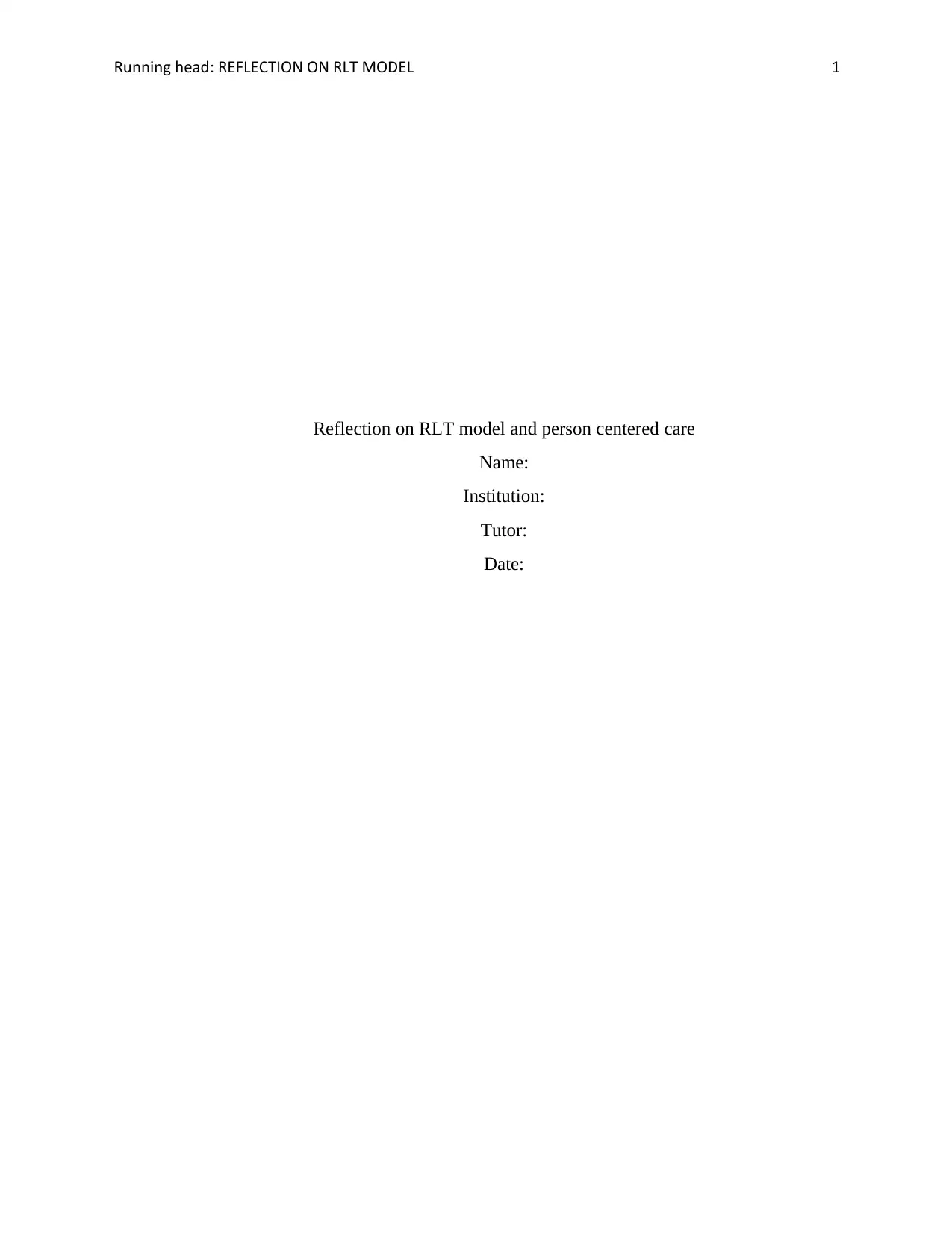
Running head: REFLECTION ON RLT MODEL 1
Reflection on RLT model and person centered care
Name:
Institution:
Tutor:
Date:
Reflection on RLT model and person centered care
Name:
Institution:
Tutor:
Date:
Paraphrase This Document
Need a fresh take? Get an instant paraphrase of this document with our AI Paraphraser
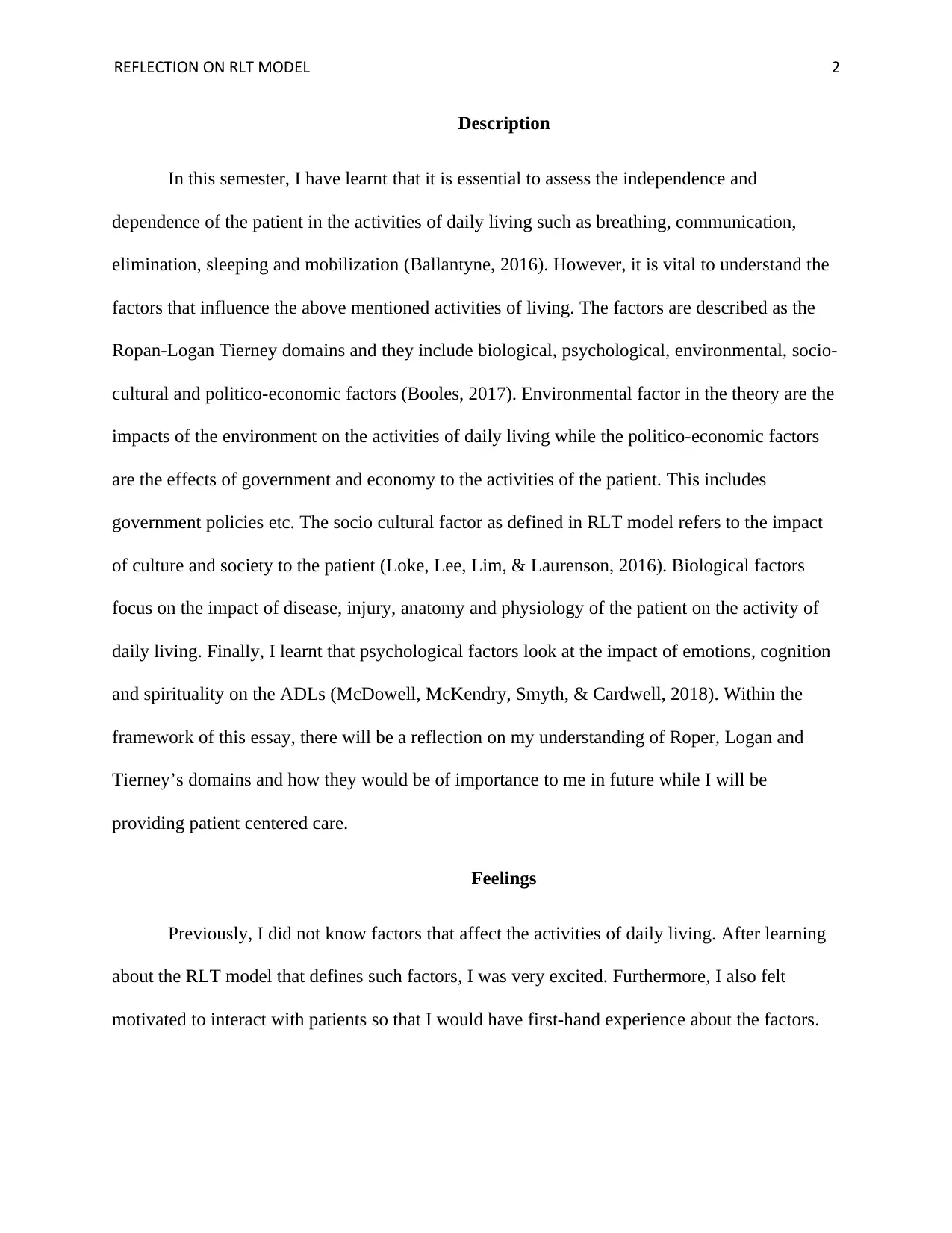
REFLECTION ON RLT MODEL 2
Description
In this semester, I have learnt that it is essential to assess the independence and
dependence of the patient in the activities of daily living such as breathing, communication,
elimination, sleeping and mobilization (Ballantyne, 2016). However, it is vital to understand the
factors that influence the above mentioned activities of living. The factors are described as the
Ropan-Logan Tierney domains and they include biological, psychological, environmental, socio-
cultural and politico-economic factors (Booles, 2017). Environmental factor in the theory are the
impacts of the environment on the activities of daily living while the politico-economic factors
are the effects of government and economy to the activities of the patient. This includes
government policies etc. The socio cultural factor as defined in RLT model refers to the impact
of culture and society to the patient (Loke, Lee, Lim, & Laurenson, 2016). Biological factors
focus on the impact of disease, injury, anatomy and physiology of the patient on the activity of
daily living. Finally, I learnt that psychological factors look at the impact of emotions, cognition
and spirituality on the ADLs (McDowell, McKendry, Smyth, & Cardwell, 2018). Within the
framework of this essay, there will be a reflection on my understanding of Roper, Logan and
Tierney’s domains and how they would be of importance to me in future while I will be
providing patient centered care.
Feelings
Previously, I did not know factors that affect the activities of daily living. After learning
about the RLT model that defines such factors, I was very excited. Furthermore, I also felt
motivated to interact with patients so that I would have first-hand experience about the factors.
Description
In this semester, I have learnt that it is essential to assess the independence and
dependence of the patient in the activities of daily living such as breathing, communication,
elimination, sleeping and mobilization (Ballantyne, 2016). However, it is vital to understand the
factors that influence the above mentioned activities of living. The factors are described as the
Ropan-Logan Tierney domains and they include biological, psychological, environmental, socio-
cultural and politico-economic factors (Booles, 2017). Environmental factor in the theory are the
impacts of the environment on the activities of daily living while the politico-economic factors
are the effects of government and economy to the activities of the patient. This includes
government policies etc. The socio cultural factor as defined in RLT model refers to the impact
of culture and society to the patient (Loke, Lee, Lim, & Laurenson, 2016). Biological factors
focus on the impact of disease, injury, anatomy and physiology of the patient on the activity of
daily living. Finally, I learnt that psychological factors look at the impact of emotions, cognition
and spirituality on the ADLs (McDowell, McKendry, Smyth, & Cardwell, 2018). Within the
framework of this essay, there will be a reflection on my understanding of Roper, Logan and
Tierney’s domains and how they would be of importance to me in future while I will be
providing patient centered care.
Feelings
Previously, I did not know factors that affect the activities of daily living. After learning
about the RLT model that defines such factors, I was very excited. Furthermore, I also felt
motivated to interact with patients so that I would have first-hand experience about the factors.
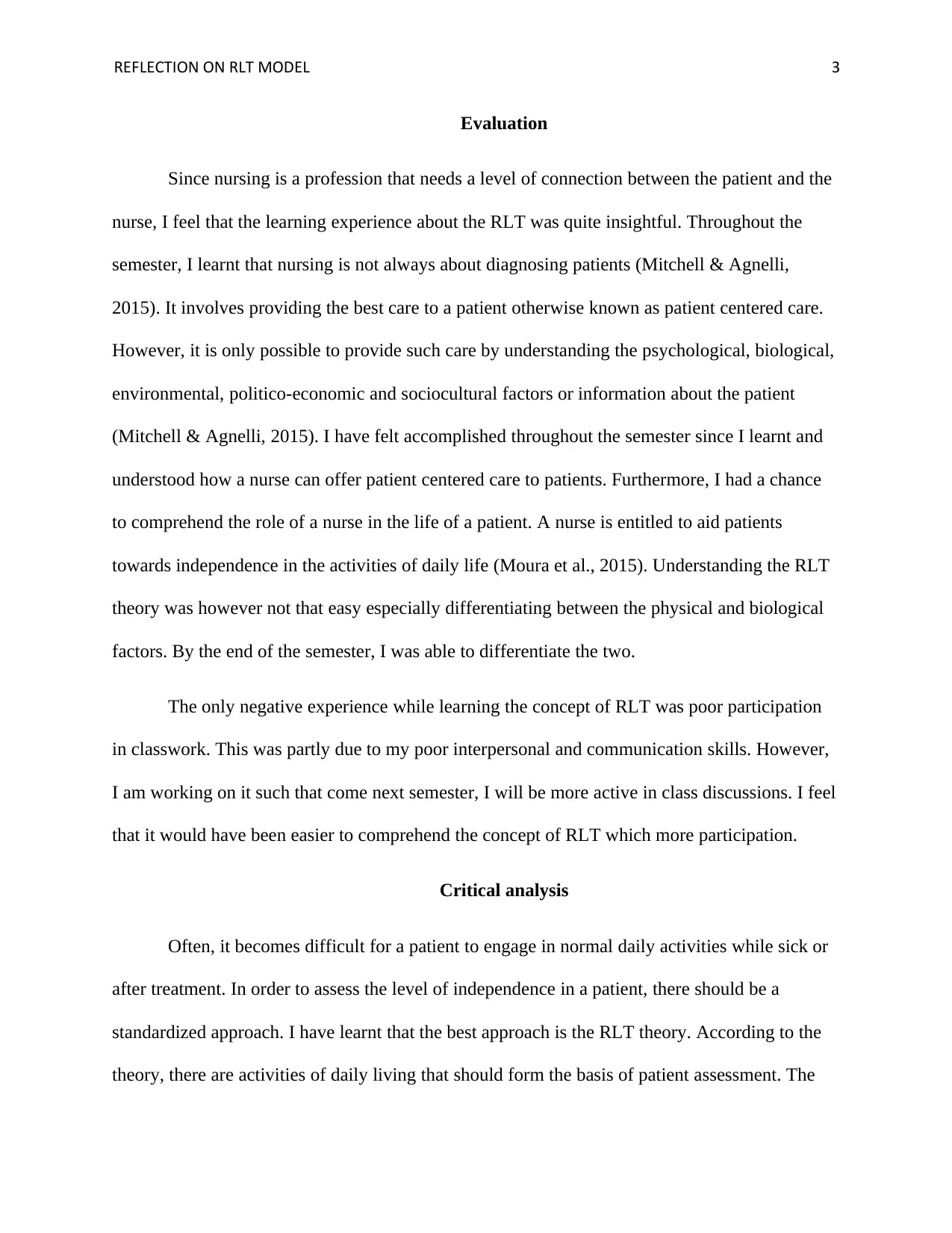
REFLECTION ON RLT MODEL 3
Evaluation
Since nursing is a profession that needs a level of connection between the patient and the
nurse, I feel that the learning experience about the RLT was quite insightful. Throughout the
semester, I learnt that nursing is not always about diagnosing patients (Mitchell & Agnelli,
2015). It involves providing the best care to a patient otherwise known as patient centered care.
However, it is only possible to provide such care by understanding the psychological, biological,
environmental, politico-economic and sociocultural factors or information about the patient
(Mitchell & Agnelli, 2015). I have felt accomplished throughout the semester since I learnt and
understood how a nurse can offer patient centered care to patients. Furthermore, I had a chance
to comprehend the role of a nurse in the life of a patient. A nurse is entitled to aid patients
towards independence in the activities of daily life (Moura et al., 2015). Understanding the RLT
theory was however not that easy especially differentiating between the physical and biological
factors. By the end of the semester, I was able to differentiate the two.
The only negative experience while learning the concept of RLT was poor participation
in classwork. This was partly due to my poor interpersonal and communication skills. However,
I am working on it such that come next semester, I will be more active in class discussions. I feel
that it would have been easier to comprehend the concept of RLT which more participation.
Critical analysis
Often, it becomes difficult for a patient to engage in normal daily activities while sick or
after treatment. In order to assess the level of independence in a patient, there should be a
standardized approach. I have learnt that the best approach is the RLT theory. According to the
theory, there are activities of daily living that should form the basis of patient assessment. The
Evaluation
Since nursing is a profession that needs a level of connection between the patient and the
nurse, I feel that the learning experience about the RLT was quite insightful. Throughout the
semester, I learnt that nursing is not always about diagnosing patients (Mitchell & Agnelli,
2015). It involves providing the best care to a patient otherwise known as patient centered care.
However, it is only possible to provide such care by understanding the psychological, biological,
environmental, politico-economic and sociocultural factors or information about the patient
(Mitchell & Agnelli, 2015). I have felt accomplished throughout the semester since I learnt and
understood how a nurse can offer patient centered care to patients. Furthermore, I had a chance
to comprehend the role of a nurse in the life of a patient. A nurse is entitled to aid patients
towards independence in the activities of daily life (Moura et al., 2015). Understanding the RLT
theory was however not that easy especially differentiating between the physical and biological
factors. By the end of the semester, I was able to differentiate the two.
The only negative experience while learning the concept of RLT was poor participation
in classwork. This was partly due to my poor interpersonal and communication skills. However,
I am working on it such that come next semester, I will be more active in class discussions. I feel
that it would have been easier to comprehend the concept of RLT which more participation.
Critical analysis
Often, it becomes difficult for a patient to engage in normal daily activities while sick or
after treatment. In order to assess the level of independence in a patient, there should be a
standardized approach. I have learnt that the best approach is the RLT theory. According to the
theory, there are activities of daily living that should form the basis of patient assessment. The
⊘ This is a preview!⊘
Do you want full access?
Subscribe today to unlock all pages.

Trusted by 1+ million students worldwide
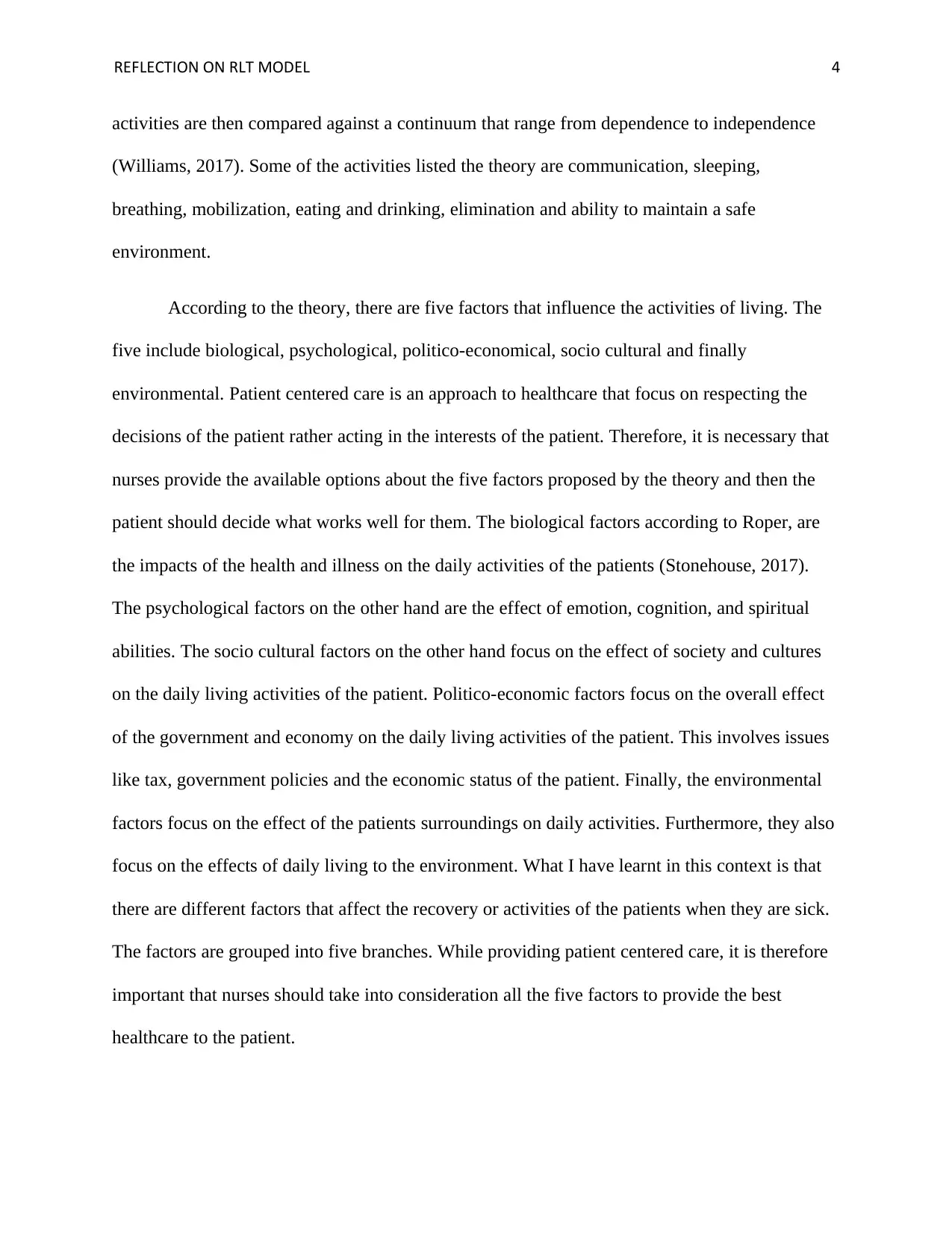
REFLECTION ON RLT MODEL 4
activities are then compared against a continuum that range from dependence to independence
(Williams, 2017). Some of the activities listed the theory are communication, sleeping,
breathing, mobilization, eating and drinking, elimination and ability to maintain a safe
environment.
According to the theory, there are five factors that influence the activities of living. The
five include biological, psychological, politico-economical, socio cultural and finally
environmental. Patient centered care is an approach to healthcare that focus on respecting the
decisions of the patient rather acting in the interests of the patient. Therefore, it is necessary that
nurses provide the available options about the five factors proposed by the theory and then the
patient should decide what works well for them. The biological factors according to Roper, are
the impacts of the health and illness on the daily activities of the patients (Stonehouse, 2017).
The psychological factors on the other hand are the effect of emotion, cognition, and spiritual
abilities. The socio cultural factors on the other hand focus on the effect of society and cultures
on the daily living activities of the patient. Politico-economic factors focus on the overall effect
of the government and economy on the daily living activities of the patient. This involves issues
like tax, government policies and the economic status of the patient. Finally, the environmental
factors focus on the effect of the patients surroundings on daily activities. Furthermore, they also
focus on the effects of daily living to the environment. What I have learnt in this context is that
there are different factors that affect the recovery or activities of the patients when they are sick.
The factors are grouped into five branches. While providing patient centered care, it is therefore
important that nurses should take into consideration all the five factors to provide the best
healthcare to the patient.
activities are then compared against a continuum that range from dependence to independence
(Williams, 2017). Some of the activities listed the theory are communication, sleeping,
breathing, mobilization, eating and drinking, elimination and ability to maintain a safe
environment.
According to the theory, there are five factors that influence the activities of living. The
five include biological, psychological, politico-economical, socio cultural and finally
environmental. Patient centered care is an approach to healthcare that focus on respecting the
decisions of the patient rather acting in the interests of the patient. Therefore, it is necessary that
nurses provide the available options about the five factors proposed by the theory and then the
patient should decide what works well for them. The biological factors according to Roper, are
the impacts of the health and illness on the daily activities of the patients (Stonehouse, 2017).
The psychological factors on the other hand are the effect of emotion, cognition, and spiritual
abilities. The socio cultural factors on the other hand focus on the effect of society and cultures
on the daily living activities of the patient. Politico-economic factors focus on the overall effect
of the government and economy on the daily living activities of the patient. This involves issues
like tax, government policies and the economic status of the patient. Finally, the environmental
factors focus on the effect of the patients surroundings on daily activities. Furthermore, they also
focus on the effects of daily living to the environment. What I have learnt in this context is that
there are different factors that affect the recovery or activities of the patients when they are sick.
The factors are grouped into five branches. While providing patient centered care, it is therefore
important that nurses should take into consideration all the five factors to provide the best
healthcare to the patient.
Paraphrase This Document
Need a fresh take? Get an instant paraphrase of this document with our AI Paraphraser
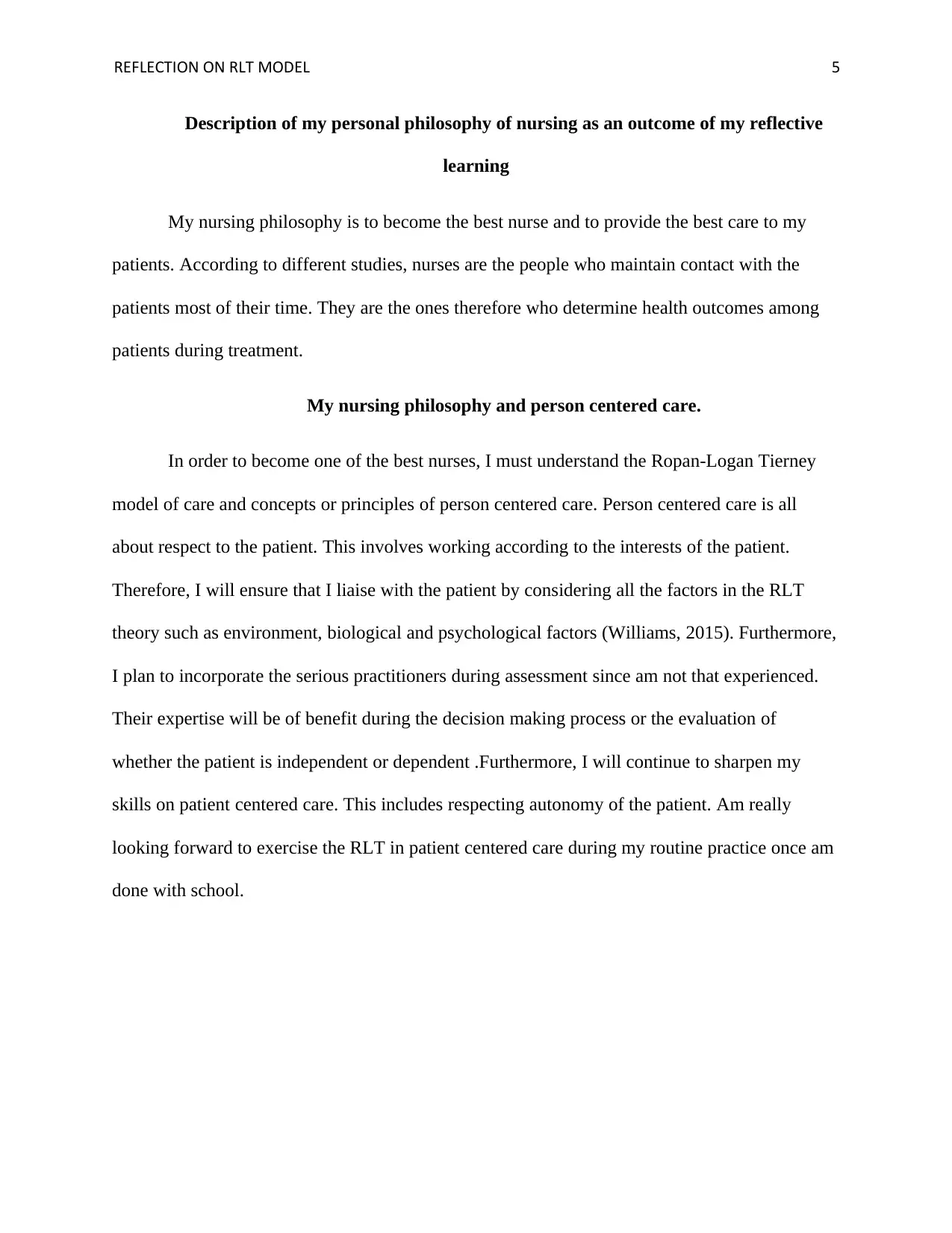
REFLECTION ON RLT MODEL 5
Description of my personal philosophy of nursing as an outcome of my reflective
learning
My nursing philosophy is to become the best nurse and to provide the best care to my
patients. According to different studies, nurses are the people who maintain contact with the
patients most of their time. They are the ones therefore who determine health outcomes among
patients during treatment.
My nursing philosophy and person centered care.
In order to become one of the best nurses, I must understand the Ropan-Logan Tierney
model of care and concepts or principles of person centered care. Person centered care is all
about respect to the patient. This involves working according to the interests of the patient.
Therefore, I will ensure that I liaise with the patient by considering all the factors in the RLT
theory such as environment, biological and psychological factors (Williams, 2015). Furthermore,
I plan to incorporate the serious practitioners during assessment since am not that experienced.
Their expertise will be of benefit during the decision making process or the evaluation of
whether the patient is independent or dependent .Furthermore, I will continue to sharpen my
skills on patient centered care. This includes respecting autonomy of the patient. Am really
looking forward to exercise the RLT in patient centered care during my routine practice once am
done with school.
Description of my personal philosophy of nursing as an outcome of my reflective
learning
My nursing philosophy is to become the best nurse and to provide the best care to my
patients. According to different studies, nurses are the people who maintain contact with the
patients most of their time. They are the ones therefore who determine health outcomes among
patients during treatment.
My nursing philosophy and person centered care.
In order to become one of the best nurses, I must understand the Ropan-Logan Tierney
model of care and concepts or principles of person centered care. Person centered care is all
about respect to the patient. This involves working according to the interests of the patient.
Therefore, I will ensure that I liaise with the patient by considering all the factors in the RLT
theory such as environment, biological and psychological factors (Williams, 2015). Furthermore,
I plan to incorporate the serious practitioners during assessment since am not that experienced.
Their expertise will be of benefit during the decision making process or the evaluation of
whether the patient is independent or dependent .Furthermore, I will continue to sharpen my
skills on patient centered care. This includes respecting autonomy of the patient. Am really
looking forward to exercise the RLT in patient centered care during my routine practice once am
done with school.
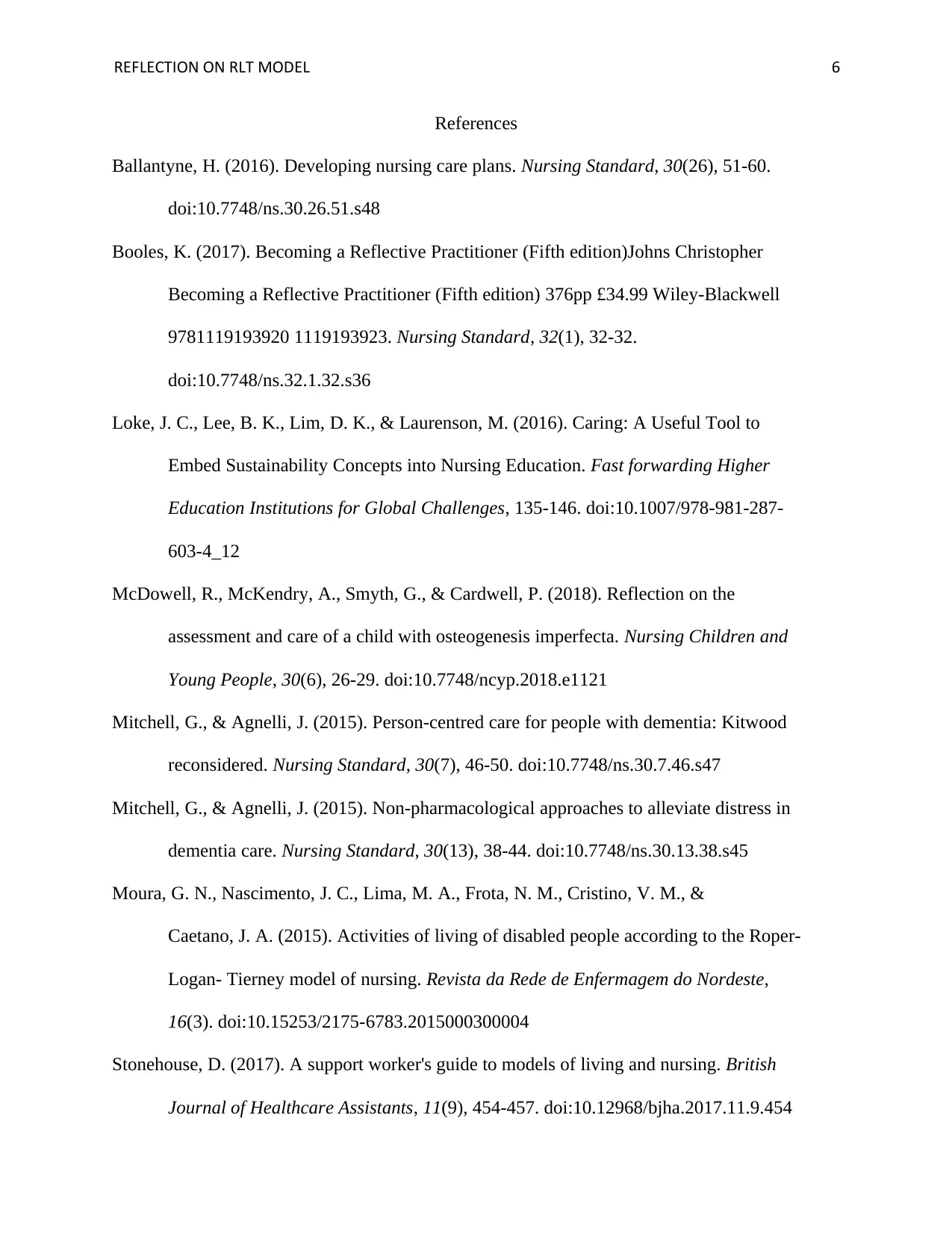
REFLECTION ON RLT MODEL 6
References
Ballantyne, H. (2016). Developing nursing care plans. Nursing Standard, 30(26), 51-60.
doi:10.7748/ns.30.26.51.s48
Booles, K. (2017). Becoming a Reflective Practitioner (Fifth edition)Johns Christopher
Becoming a Reflective Practitioner (Fifth edition) 376pp £34.99 Wiley-Blackwell
9781119193920 1119193923. Nursing Standard, 32(1), 32-32.
doi:10.7748/ns.32.1.32.s36
Loke, J. C., Lee, B. K., Lim, D. K., & Laurenson, M. (2016). Caring: A Useful Tool to
Embed Sustainability Concepts into Nursing Education. Fast forwarding Higher
Education Institutions for Global Challenges, 135-146. doi:10.1007/978-981-287-
603-4_12
McDowell, R., McKendry, A., Smyth, G., & Cardwell, P. (2018). Reflection on the
assessment and care of a child with osteogenesis imperfecta. Nursing Children and
Young People, 30(6), 26-29. doi:10.7748/ncyp.2018.e1121
Mitchell, G., & Agnelli, J. (2015). Person-centred care for people with dementia: Kitwood
reconsidered. Nursing Standard, 30(7), 46-50. doi:10.7748/ns.30.7.46.s47
Mitchell, G., & Agnelli, J. (2015). Non-pharmacological approaches to alleviate distress in
dementia care. Nursing Standard, 30(13), 38-44. doi:10.7748/ns.30.13.38.s45
Moura, G. N., Nascimento, J. C., Lima, M. A., Frota, N. M., Cristino, V. M., &
Caetano, J. A. (2015). Activities of living of disabled people according to the Roper-
Logan- Tierney model of nursing. Revista da Rede de Enfermagem do Nordeste,
16(3). doi:10.15253/2175-6783.2015000300004
Stonehouse, D. (2017). A support worker's guide to models of living and nursing. British
Journal of Healthcare Assistants, 11(9), 454-457. doi:10.12968/bjha.2017.11.9.454
References
Ballantyne, H. (2016). Developing nursing care plans. Nursing Standard, 30(26), 51-60.
doi:10.7748/ns.30.26.51.s48
Booles, K. (2017). Becoming a Reflective Practitioner (Fifth edition)Johns Christopher
Becoming a Reflective Practitioner (Fifth edition) 376pp £34.99 Wiley-Blackwell
9781119193920 1119193923. Nursing Standard, 32(1), 32-32.
doi:10.7748/ns.32.1.32.s36
Loke, J. C., Lee, B. K., Lim, D. K., & Laurenson, M. (2016). Caring: A Useful Tool to
Embed Sustainability Concepts into Nursing Education. Fast forwarding Higher
Education Institutions for Global Challenges, 135-146. doi:10.1007/978-981-287-
603-4_12
McDowell, R., McKendry, A., Smyth, G., & Cardwell, P. (2018). Reflection on the
assessment and care of a child with osteogenesis imperfecta. Nursing Children and
Young People, 30(6), 26-29. doi:10.7748/ncyp.2018.e1121
Mitchell, G., & Agnelli, J. (2015). Person-centred care for people with dementia: Kitwood
reconsidered. Nursing Standard, 30(7), 46-50. doi:10.7748/ns.30.7.46.s47
Mitchell, G., & Agnelli, J. (2015). Non-pharmacological approaches to alleviate distress in
dementia care. Nursing Standard, 30(13), 38-44. doi:10.7748/ns.30.13.38.s45
Moura, G. N., Nascimento, J. C., Lima, M. A., Frota, N. M., Cristino, V. M., &
Caetano, J. A. (2015). Activities of living of disabled people according to the Roper-
Logan- Tierney model of nursing. Revista da Rede de Enfermagem do Nordeste,
16(3). doi:10.15253/2175-6783.2015000300004
Stonehouse, D. (2017). A support worker's guide to models of living and nursing. British
Journal of Healthcare Assistants, 11(9), 454-457. doi:10.12968/bjha.2017.11.9.454
⊘ This is a preview!⊘
Do you want full access?
Subscribe today to unlock all pages.

Trusted by 1+ million students worldwide
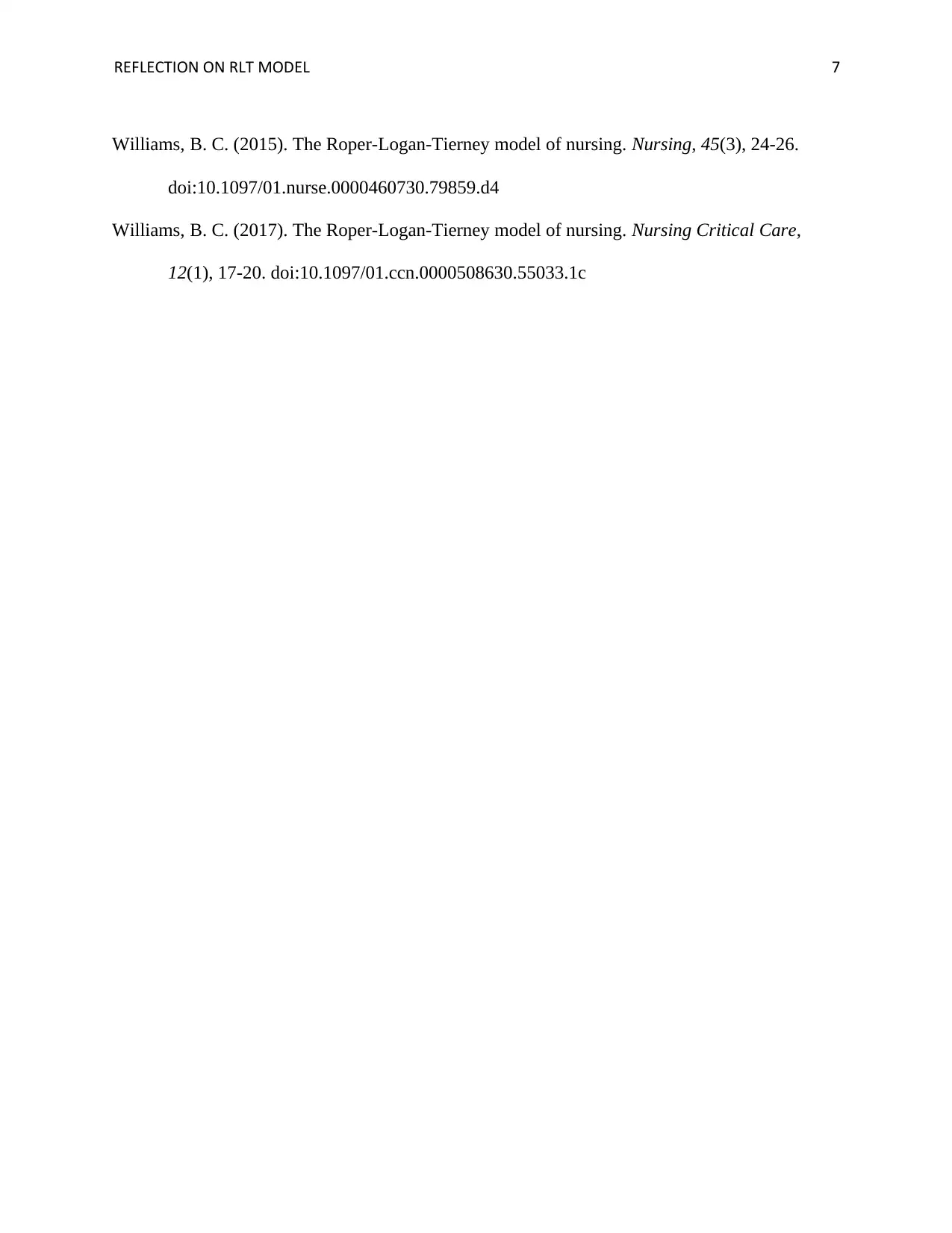
REFLECTION ON RLT MODEL 7
Williams, B. C. (2015). The Roper-Logan-Tierney model of nursing. Nursing, 45(3), 24-26.
doi:10.1097/01.nurse.0000460730.79859.d4
Williams, B. C. (2017). The Roper-Logan-Tierney model of nursing. Nursing Critical Care,
12(1), 17-20. doi:10.1097/01.ccn.0000508630.55033.1c
Williams, B. C. (2015). The Roper-Logan-Tierney model of nursing. Nursing, 45(3), 24-26.
doi:10.1097/01.nurse.0000460730.79859.d4
Williams, B. C. (2017). The Roper-Logan-Tierney model of nursing. Nursing Critical Care,
12(1), 17-20. doi:10.1097/01.ccn.0000508630.55033.1c
1 out of 7
Related Documents
Your All-in-One AI-Powered Toolkit for Academic Success.
+13062052269
info@desklib.com
Available 24*7 on WhatsApp / Email
![[object Object]](/_next/static/media/star-bottom.7253800d.svg)
Unlock your academic potential
Copyright © 2020–2025 A2Z Services. All Rights Reserved. Developed and managed by ZUCOL.




